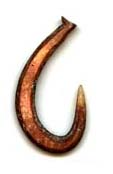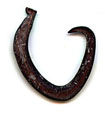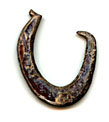
back *****************VOLUME 17 page 9 ***************** next page
Curved Shank
*****This group was designated by Suggs (1961:81) who identified the diagnostic features as a gradually, forward curved shank, a tight bend, and a
straight point directed back towards the head. In comparison with Rotating hooks, the bend of Curved Shank hooks is narrower and the point is longer in relation to the shank, the point of Curved Shank hooks is never directed below the head.
***** Fishhooks of this group are well represented in Settlement and Developmental culture assemblages of Hane and Ha'atuatua but they are rare in the early Ha'atuatua assemblage. At Hanamiai they were found in Zones GH/G and G.

*****This type is represented in the Tubuai collection by the rather excellent complete specimen above and the group has been reviewed in the Comparative Diagram 17.7. I think the classification of this type has been rather complicated by the addition of the group called Narrow Bend Curved Shank. While the definition of a "straight point directed towards the head" is not well demonstrated by Roletts illustrated example of the type (Fig. 7.1s) however it would appear that some of the Marquesan hooks which resemble the type are more curved in the bend (see Sinoto, 1966, Figure 4a, 8). Thus I hesitate to include Roletts final group, the Narrow Bend Curved Shank.

*****It may be possible to create an "Open Curved Shank" Type as in the above example and also certain of Sinoto's Marquesan examples from Hane.
*****A close look at the larger specimens of this type and similar large specimens of the Obtuse Recurved Point hook indicates a close relationship between these hooks and it may be that the Obtuse forms are but refined improvements on the older Curved Shank model. This is a very important early form that I think can again be linked to the early Pukapuka hooks, and the Hawaiian examples which appear as being variations of this form.
Flat Bend
***** One complete hook and a number of fragments of this type suggest that this unique form is a deliberate invention. The hooks are of medium size and may demonstrate angular shanks and obtuse recurved points

*****In Diagram 25.26a I have assembled three Flat Bend examples, the head form is very interesting being a simple knob without an inside step.
Acute Rotating
*****This hook is actually a mixture of types, including bent or angular shank and acute recurved point. As it is also one of a number of different rotating hook forms, I have taken the liberty of classifying the various rotating types with an additional descriptive.

*****The above flawless AHOAPOFATU example is of medium size, the line attachment device being but a simple knob and slight inside step, similar in some ways to the curved shank example 452-318-PSH-1 also from AHOAPOFATU (see VOLUME 15, 28/07/1990. and Diagram 15.36a).
Obtuse Rotating
*****At first glance one might be tempted to classify this hook as an obtuse recurved point hook however we see that the bend in the shank of that type is near the base of the hook while the bend of the hook is more elbow like than this new form.

*****This hook is obviously related to the acute form above but shows some subtile and important differences. We see that the line attachment devise is just a basic knob, without an inside step elaboration. The point tip is directed towards the head as opposed to much lower down the shank in the acute example. Note too the more robust nature of this hook, which is also thicker than the acute form. A thorough inspection of the Marquesan hooks in print, including the fishhooks classified by Rolett does not reveal these two variations.
Comparisons
*****The Marquesan types then prove to be a valuable aid to the classification of the Tubuai hooks, however one or two hooks do not seem to fit entirely and could be classified in separate groupings. (Note: as per the recent inclusion of Reversed Shank and Flat Bend hooks). Rolett has obviously realized the great importance of these artifacts but has failed to give a detailed analysis of line attachment devices, (head forms, knobs and notches). Such information being indispensable in comparative studies, in fact a true comparative analysis is impossible without these important details. Also limiting is the absence of well illustrated examples at scales which could reveal the more subtle details such as head forms etc.
***** Even within this present work I have, (for the purpose of assembling a greater number of hooks on one page) illustrated certain hooks at a 1/1 scale (Diagram 17.13), however this scale is totally insufficient for the serious researcher, who will want to see the important details of these hooks which are only apparent at a larger scale.
*****The classification of the Polynesian one piece fishhooks hooks could be perhaps simplified by dividing them into two groups, Rotating and Jabbing. The rotating hooks then defined by Varieties such as Circular, Acute, Obtuse and so on. While the Jabbing hooks would be less varied with perhaps the Curved Shank hooks included being possibly a sort of rotating jabbing form. The point tips of the hooks could serve as definitive indicators. Rotating hooks (other than the perfectly circular forms) therefore being hooks with point tip recurved or incurved and designated as obtuse, or acute. At the moment the terms such as curved shank, angular shank, bent shank, recurved point and so on, are being used rather loosely and these definitions will need to be refined, the risk being to confuse 'types' with definitions of types.
*****All considered, it may be, rather premature to compare the present limited Tubuai collection of fishhooks with those of the Marquesas. The chronological implications of certain forms are however of much importance and Roletts' analysis of the changes within the Marquesan fishhooks directly attributable to chronology are highly interesting. In comparing the Hane and Hanamiai hooks he states:
*****"As a group, the early Hane fishhooks are remarkably similar to those from Hanamiai. Like the Hanamiai Zone GH/H and G fishhook assemblages, those from Levels V and VI of Area B show an overwhelming predominance of fishhooks with curved and angular shanks."
*****The appearance of these forms in Tubuai reaffirms the possibility that the settlement of Tubuai may have occurred at an early period, by a culture directly related to if not identical with that found in the early Marquesan and Society Island settlements. Rolett further confirms that the early forms found at the Hane and Hanamiai sites appear to be also represented among excavated fishhook assemblages from sites on Pukapuka in the Cook Islands (dating to around the second or third centuries BC?) "The early Pukapuka forms include Circular, Curved Shank, and Angular Shank hooks (Chikamori 1988)."
Return to the top of the page